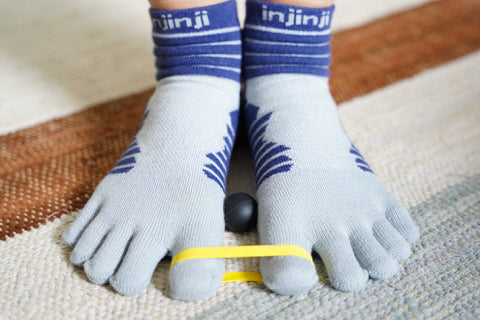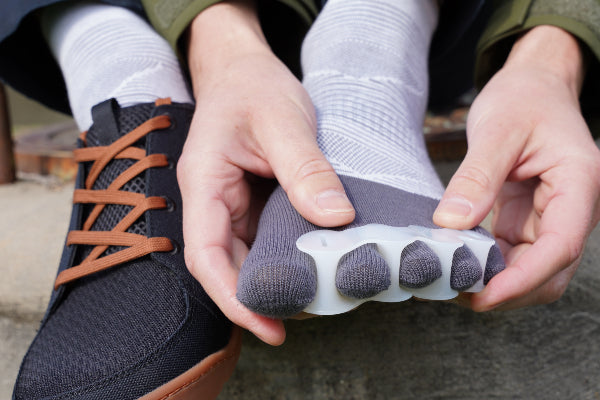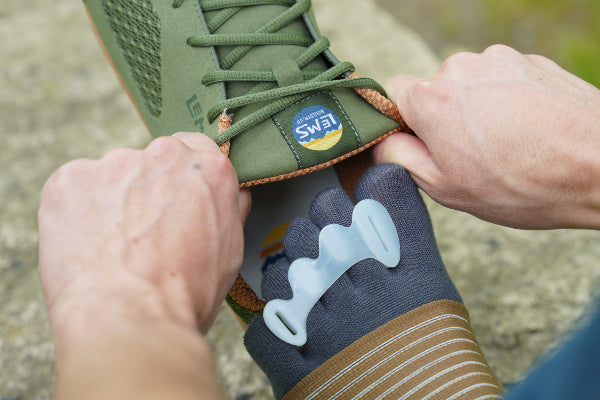Bunions: Conventional vs. Natural Approaches

In this video, Dr. Ray McClanahan, a sports podiatrist at Northwest Foot and Ankle and the inventor of Correct Toes, discusses how bunions are treated using conventional... Read more
This video, featuring Dr. Ray McClanahan, a sports podiatrist at Northwest Foot and Ankle the inventor of Correct Toes, answers several questions that we at Natural Footgear are frequently asked:
Are bunions hereditary? Is there a way to prevent bunions from forming? If I already have a bunion, do I need to have surgery to correct it?
In a lot of cases, people assume they are predisposed to developing bunions because their older relatives developed bunions. But it's impossible to state that bunions are hereditary if all the members of one's family have worn shoes with tapering toe boxes. Shoes with this injurious design element hold the big toe in a bunion configuration for prolonged periods and are the direct cause of bunions in most people. Some individuals may have differences in the plasticity and elasticity of their soft tissues that make bunions more likely to occur when wearing conventional footwear, but very few (if any) people actually possess a genetic component that directly causes bunions.

We are not born with bunions. It's only after adopting shoes with tapering toe boxes that this deformity begins to manifest. Footwear, beyond the earliest years of life, is not designed for a normal human foot. In fact, the current system for determining proper shoe width (Brannock Device) fails most people because it assumes that the foot should be widest at the ball, not at the ends of the toes.
Most footwear on the market today is not compatible with natural foot health and does not respect normal foot anatomy. In the above video, Dr. Ray makes the point that cultures around the world have deformed their bodies for the purposes of beauty and/or the psychological need to fit in. In our society, we often wear foot-deforming footwear to fulfill a societal ideal, notes Dr. Ray.
Dr. Ray, in the video, also mentions a terrific article written by Dr. William Rossi, a naturopathically-minded podiatrist, that discusses the topic of fashion and foot deformation. This article delves deeper into the psychosocial reasons that we willingly (and often unknowingly) adopt foot-deforming footwear and how this compares to other cultures' use of body-deforming practices.

An interesting study relating to the topic of bunions and heredity was published in the American Journal of Physical Anthropology in 2005. The study, conducted by S.A. Mays, examined the condition called hallux valgus—an abnormal deviation of the big toe toward the midline of the foot; something generally considered the precursor of a bunion—in two series of medieval skeletons: One series from the earlier Medieval period, one series from the later Medieval period. Here is the abstract from the study:
Hallux valgus is the abnormal lateral deviation of the great toe. The principal cause is biomechanical, specifically the habitual use of footwear which constricts the toes. In this study, descriptions of the anatomical changes of hallux valgus from published cadaveric and clinical studies were used to generate criteria for identifying the condition in ancient skeletal remains.
The value of systematic scoring of hallux valgus in paleopathology is illustrated using two British skeletal series, one dating from the earlier and one from the later Medieval period. It was found that hallux valgus was restricted to later Medieval burials. This appears consistent with archaeological and historical evidence for a rise in popularity, during the late Medieval period (at least among the richer social classes), of narrow, pointed shoes which would have constricted the toes.
Using ancient skeletal remains, this study makes the point that, before people started adopting toe-constricting footwear, toe alignment—including alignment of the big toe—was better. It's a common sense conclusion that's relevant to the discussion at hand regarding bunions and heredity. You can read the full study here.
Given that bunions are a progressive dislocation of the big toe's metatarsophalangeal (MTP) joint, and given that bunions are not hereditary, what's the best way to prevent them from occurring?
The answer is simultaneously elegantly simple and frustratingly challenging. Elegantly simple because the solution—avoid offending footwear—is clear and unambiguous. Frustratingly challenging because of the relative dearth of footwear options that offer you, the wearer, the ability to realize optimal toe splay, unimpeded by the toe deforming effects of tapering toe boxes (thankfully, as time goes by, there are increasingly more decent options are available to consumers—a positive trend that we hope continues).
The truth is that the bunion formation process begins early in life, with the adoption of footwear that squeezes the forefoot and (usually painlessly) pinches the toes together. With the toes held in this unnatural configuration for prolonged periods during the developmental phase of life, foot tissues maladapt and begin to hold this unfavorable configuration even when the offending stimulus (conventional footwear) is removed. Most of us continue wearing footwear that is not shaped like an actual human foot during adolescence and throughout our adult years, further reinforcing the toe deformities that began to manifest in early childhood.
In our experience, we have found that there are four main things you can do to help prevent bunions:
If you have kids, you are in the best possible position to give them the gift of lifelong foot health (or at least a really great start in life in terms of their foot form and function). This video goes into greater detail about how to choose foot-healthy shoes for kids.
SHOP MEN'S FOOTWEAR SHOP WOMEN'S FOOTWEARWhen it comes to bunions, the simplest and most effective approach is always to prevent them from occurring in the first place. However, most people only discover later in life, after a bunion has already formed, that this foot problem can be easily avoided. It's an unfortunate scenario, but it is exceedingly common. And so, the question then becomes: What can be done to help reverse an existing bunion and achieve a more optimal toe alignment and foot configuration?
In our experience, we have found the following five steps to be very helpful in addressing an existing bunion (regardless of the stage of bunion development) and rehabilitating the feet and toes:
Most people with bunions who adopt the above approaches experience at least some degree of bunion correction over time (in many cases, full correction). One scenario in which a bunion may not undergo progressive reversal using these strategies is when the big toe's MTP joint is fused and the big toe itself no longer has any appreciable range of motion. In cases such as these, surgery may indeed be a viable option, followed, of course, by the implementation of the natural approaches discussed here to prevent a recurrence of the bunion.
SHOP CORRECT TOES SHOP INJINJI TOE SOCKS SHOP PEDAG METATARSAL PADS SHOP BLACKBOARD TOEBANDS
In the video at the top of this article, Dr. Ray concludes that bunions are simple to address if you understand proper foot mechanics and the role of footwear in the onset of this problem. Surgery is rarely the best option for a bunion (recurrences are common), and bunions truly are preventable if you understand their underlying cause and take appropriate steps to safeguard yourself.
Bunion prevention begins in childhood with the adoption of appropriately foot-shaped footwear, and so it's incumbent upon parents to understand the importance of natural foot alignment and then secure the best possible footwear for their children. In order to ensure foot health throughout your own lifespan, it's important to apply the same principles you use in selecting your children's footwear when selecting your own footwear. The key is finding footwear that allows your foot to function like a healthy bare foot inside your shoe in addition to adopting other essential footgear and performing helpful foot care exercises.
If you have any questions for us about this article, please feel free to leave a comment in the comments section below or reach out to us via our contact form. Here's wishing you straight, splayed toes and a bunion-free life!
Disclaimer:
The above content is for educational or informational purposes only and is not intended to replace or augment professional medical instruction, diagnosis, or treatment. Read full disclaimer here.$65.00
$10.00
$14.00
$14.00
$30.00
$30.00

In this video, Dr. Ray McClanahan, a sports podiatrist at Northwest Foot and Ankle and the inventor of Correct Toes, discusses how bunions are treated using conventional... Read more

Using Correct Toes in combination with men's and women's foot-healthy footwear is one of the best strategies to help reverse or prevent bunions, but what else... Read more


Dr. McClanahan:
I was fascinated with your various videos on line. Unfortunately I only discovered all this after I had my two bunions operated on (one of them twice!). I am 75 years old. Do you think that wearing the Correct Toes and of course wearing the appropriate footwear can still help me stop or even reverse the advance and recurrence of my bunions?
Hi, Sylvia,
Thank you for your message. Dr. McClanahan is our personal foot health mentor, and we love his videos too! A lot of folks in their seventies have benefitted from natural foot approaches, including the adoption of Correct Toes and foot-healthy footwear. How you personally respond to these approaches depends on a lot of factors, including the mobility of your toes and the tone of the tissues (muscles, ligaments, etc.) acting on your toes. Here is a video (www.youtube.com/watch?v=UuDbEEAGZ94&feature=youtu.be) that discusses the possible benefits of natural foot health in older individuals.
Kind regards,
Marty Hughes, DC
After years of having bunions, I bought Correct Toes and I believe they are helping. I have also purchased and wear only Altra shoes (for after-work wear) and Olukai (for work) and I think these are the best two shoes to give the most room for the toes in general and while wearing Correct Toes. Unfortunately, in the last year, I have developed a hammertoe and can feel that my hammertoe is causing additional problems. Do you think the hammertoe is reversible? I’m still very active (I’m in my early 40’s) and still play competitive tennis and am hoping to have less foot pain. Please let me know thoughts.
Greetings, Schuyler,
Thank you for your message. In our experience, we’ve found that Correct Toes can be extremely helpful in relieving hammertoe symptoms while simultaneously straightening and aligning toes with their corresponding metatarsal bones.
I might suggest performing a few modifications to your Correct Toes to help them fit over your hammertoe, enhance your comfort during wear, and to help correct the hammertoe itself. Check out this video for comprehensive directions on how to modify your Correct Toes (fast foward to 13:34 of the video for the hammertoe modification, specifically):
www.naturalfootgear.com/blogs/product-info/17921896-correct-toes-modifications-comprehensive
Also, the use of metatarsal pads (www.naturalfootgear.com/collections/foot-pads/products/pedag-metatarsal-pads) can help to restore a balance between the toe flexor and extensor tendons. Pair the use of these products (Correct Toes and metatarsal pads) with the Hammertoe Stretch & Mobilization technique (www.naturalfootgear.com/blogs/education/17883464-hammertoe-stretch-mobilization) to restore foot/toe tendon balance and align your toes back to the way nature intended.
If you would like to learn more about hammertoes and strategies to help achieve optimal foot health, you can sign up for our free course on hammertoes here:
www.naturalfootgear.com/pages/do-you-have-foot-pain
Let us know if you have any further questions. Wishing you all the best in foot health!
Kind regards,
Laura Trentman
The stock photo of two sets of adult feet and one set of baby feet is very interesting, because although the adults do not appear to have bunions, their smaller toes look very squished together, especially compared to the baby’s. From what I can see, most adults in this country have feet that are that shape—literally molded by shoes! I used to think my feet were deformed because my toes spread out and are wider than the balls, but thanks to your website, I realize that they are actually the shape of a normal foot that hasn’t been deformed by shoes. It’s great to finally know that I’m normal and to be able to find shoes that don’t hurt.
Hi, Karen,
Thank you for sharing your astute observation! You are absolutely correct that most adults in the US (and in many societies around the world) have feet that are molded by shoes and misshapen (with many sets of feet heading toward bunion formation). Definitely celebrate the fact that your feet are normal; that’s a rare thing in this day and age! We wish you much success in finding footwear that conforms to your foot (instead of the other way around, as is usually the case).
Kind regards,
Marty Hughes, DC